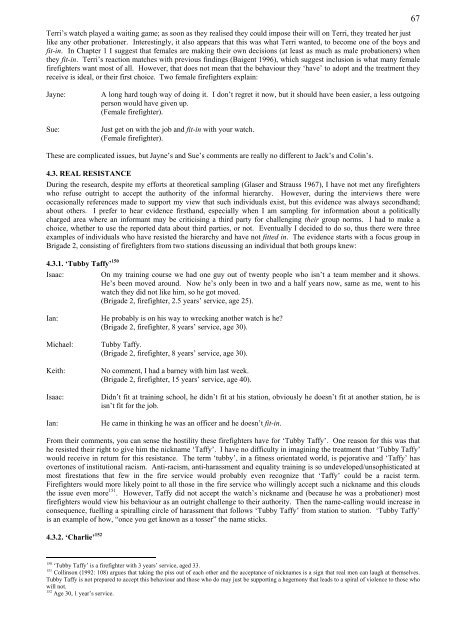One more last working class hero
One more last working class hero
One more last working class hero
Create successful ePaper yourself
Turn your PDF publications into a flip-book with our unique Google optimized e-Paper software.
Terri’s watch played a waiting game; as soon as they realised they could impose their will on Terri, they treated her just<br />
like any other probationer. Interestingly, it also appears that this was what Terri wanted, to become one of the boys and<br />
fit-in. In Chapter 1 I suggest that females are making their own decisions (at least as much as male probationers) when<br />
they fit-in. Terri’s reaction matches with previous findings (Baigent 1996), which suggest inclusion is what many female<br />
firefighters want most of all. However, that does not mean that the behaviour they ‘have’ to adopt and the treatment they<br />
receive is ideal, or their first choice. Two female firefighters explain:<br />
67<br />
Jayne:<br />
Sue:<br />
A long hard tough way of doing it. I don’t regret it now, but it should have been easier, a less outgoing<br />
person would have given up.<br />
(Female firefighter).<br />
Just get on with the job and fit-in with your watch.<br />
(Female firefighter).<br />
These are complicated issues, but Jayne’s and Sue’s comments are really no different to Jack’s and Colin’s.<br />
4.3. REAL RESISTANCE<br />
During the research, despite my efforts at theoretical sampling (Glaser and Strauss 1967), I have not met any firefighters<br />
who refuse outright to accept the authority of the informal hierarchy. However, during the interviews there were<br />
occasionally references made to support my view that such individuals exist, but this evidence was always secondhand;<br />
about others. I prefer to hear evidence firsthand, especially when I am sampling for information about a politically<br />
charged area where an informant may be criticising a third party for challenging their group norms. I had to make a<br />
choice, whether to use the reported data about third parties, or not. Eventually I decided to do so, thus there were three<br />
examples of individuals who have resisted the hierarchy and have not fitted in. The evidence starts with a focus group in<br />
Brigade 2, consisting of firefighters from two stations discussing an individual that both groups knew:<br />
4.3.1. ‘Tubby Taffy’ 150<br />
Isaac: On my training course we had one guy out of twenty people who isn’t a team member and it shows.<br />
He’s been moved around. Now he’s only been in two and a half years now, same as me, went to his<br />
watch they did not like him, so he got moved.<br />
(Brigade 2, firefighter, 2.5 years’ service, age 25).<br />
Ian:<br />
Michael:<br />
Keith:<br />
Isaac:<br />
Ian:<br />
He probably is on his way to wrecking another watch is he?<br />
(Brigade 2, firefighter, 8 years’ service, age 30).<br />
Tubby Taffy.<br />
(Brigade 2, firefighter, 8 years’ service, age 30).<br />
No comment, I had a barney with him <strong>last</strong> week.<br />
(Brigade 2, firefighter, 15 years’ service, age 40).<br />
Didn’t fit at training school, he didn’t fit at his station, obviously he doesn’t fit at another station, he is<br />
isn’t fit for the job.<br />
He came in thinking he was an officer and he doesn’t fit-in.<br />
From their comments, you can sense the hostility these firefighters have for ‘Tubby Taffy’. <strong>One</strong> reason for this was that<br />
he resisted their right to give him the nickname ‘Taffy’. I have no difficulty in imagining the treatment that ‘Tubby Taffy’<br />
would receive in return for this resistance. The term ‘tubby’, in a fitness orientated world, is pejorative and ‘Taffy’ has<br />
overtones of institutional racism. Anti-racism, anti-harassment and equality training is so undeveloped/unsophisticated at<br />
most firestations that few in the fire service would probably even recognize that ‘Taffy’ could be a racist term.<br />
Firefighters would <strong>more</strong> likely point to all those in the fire service who willingly accept such a nickname and this clouds<br />
the issue even <strong>more</strong> 151 . However, Taffy did not accept the watch’s nickname and (because he was a probationer) most<br />
firefighters would view his behaviour as an outright challenge to their authority. Then the name-calling would increase in<br />
consequence, fuelling a spiralling circle of harassment that follows ‘Tubby Taffy’ from station to station. ‘Tubby Taffy’<br />
is an example of how, “once you get known as a tosser” the name sticks.<br />
4.3.2. ‘Charlie’ 152<br />
150 ‘Tubby Taffy’ is a firefighter with 3 years’ service, aged 33.<br />
151 Collinson (1992: 108) argues that taking the piss out of each other and the acceptance of nicknames is a sign that real men can laugh at themselves.<br />
Tubby Taffy is not prepared to accept this behaviour and those who do may just be supporting a hegemony that leads to a spiral of violence to those who<br />
will not.<br />
152 Age 30, 1 year’s service.
















